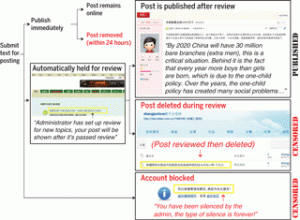Science 22 August 2014:
Vol. 345 no. 6199
DOI: 10.1126/science.1251722
RESEARCH ARTICLE
Gary King1,*, Jennifer Pan1, Margaret E. Roberts2
+ Author Affiliations
1Institute for Quantitative Social Science, Harvard University, Cambridge, MA 02138, USA.
2Department of Political Science, University of California, San Diego, La Jolla, CA 92093, USA.
↵*Corresponding author. E-mail: [email protected]
ABSTRACTSTRUCTURED ABSTRACTEDITOR’S SUMMARY
Introduction
Censorship has a long history in China, extending from the efforts of Emperor Qin to burn Confucian texts in the third century BCE to the control of traditional broadcast media under Communist Party rule. However, with the rise of the Internet and new media platforms, more than 1.3 billion people can now broadcast their individual views, making information far more diffuse and considerably harder to control. In response, the government has built a massive social media censorship organization, the result of which constitutes the largest selective suppression of human communication in the recorded history of any country. We show that this large system, designed to suppress information, paradoxically leaves large footprints and so reveals a great deal about itself and the intentions of the government.

The Chinese censorship decision tree. The pictures shown are examples of real (and typical) websites, along with our translations.
Rationale
Chinese censorship of individual social media posts occurs at two levels: (i)
Many tens of thousands of censors, working inside Chinese social media firms and government at several levels, read individual social media posts, and decide which ones to take down. (ii) They also read social media submissions that are prevented from being posted by automated keyword filters, and decide which ones to publish.
To study the first level, we devised an observational study to download published Chinese social media posts before the government could censor them, and to revisit each from a worldwide network of computers to see which was censored. To study the second level, we conducted the first largescale experimental study of censorship by creating accounts on numerous social media sites throughout China, submitting texts with different randomly assigned content to each, and detecting from a worldwide network of computers which ones were censored.
